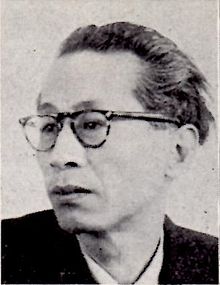Kitazono Katsue
Kitazono Katsue ( Japanese 北 園 克 衛 , also: Kitasono Katsue , real name: Hashimoto Kenkichi ( 橋本 健 吉 ); born October 29, 1902 , in Ise , Mie Prefecture ; † June 6, 1978 , Tokyo Prefecture ) was a Japanese poet and photographer . His brother was the sculptor Hashimoto Heihachi .
Life
Kitazono came to Tokyo in 1919 and there got to know European Dadaist and Surrealist literature. He published his first own poems in 1924 in the first issue of Nogawa Ryu's magazine Ge.Gjmgjgam.Prrr.Gjmgem (sic!). He was the editor-in-chief of the second issue of the magazine. The literary journals that he published in later years include Madame Blanche and, from 1935, VOU .
In 1929 his White Album ( 白 の ア ル バ ム , Shiro no arubamu ) was published, the first of more than twenty volumes of poetry, which is considered his most important work. He dedicated his Opera Poetica (1934), written in English , to Paul Éluard . From 1936 he joined a pen friendship with Ezra Pound . Both influenced each other in their work and supported each other, among other things, in the publication of works.
The Second World War marked a deep turning point in Kitasono's life. His first major publication after the war was the 1951 volume of poetry Black Fire ( 黒 い 火 , Kuroi hi ) with elements of visual poetry . Since the mid-1950s, he was also influenced by concrete poetry . Under the influence of the work of his friend, the photographer Yamamoto Kansuke , he created a combination of poetry and photography, which he called “plastic poetry” ( プ ラ ス テ ィ ッ ク ・ ポ エ ム , plastic poem ).
For a long time, Asian avant-garde literature was considered epigonal, and language barriers made publication in the Western world difficult. His work became better known through John Solt's publication Shredding the Tapestry of Meaning . A selection of his poems was published under the title oceans beyond monotonous space .
literature
Web links
- Karl Young: Introduction to Oceans Beyond Monotonous Space Selected Poems of Kitasono Katue
- E-Learning Queen - Japanese Avant-Garde Visual Poetry: Kitasono Katue
- Big Bridge: Oceans Beyond Monotonous Space: Selected Poems of Kitasono Katue - First Responses
- J. Thomas Rimer, Van C. Gessel: The Columbia Anthology of Modern Japanese Literature: From Restoration to Occupation, 1868-1945 . New edition Columbia University Press, 2010, ISBN 978-0-231-52164-2 , p. 599 ff, limited preview in Google Book Search
Individual evidence
| personal data | |
|---|---|
| SURNAME | Kitazono, Katsue |
| ALTERNATIVE NAMES | 北 園 克 衛 (Japanese); Hashimoto Kenkichi (real name); 橋本 健 吉 (real name, Japanese) |
| BRIEF DESCRIPTION | Japanese lyric poet |
| DATE OF BIRTH | October 29, 1902 |
| PLACE OF BIRTH | Ise , Mie Prefecture |
| DATE OF DEATH | June 6, 1978 |
| Place of death | Tokyo prefecture |
